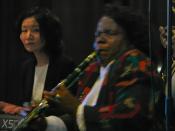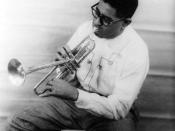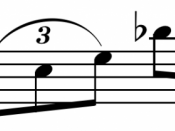6/11/2007
Music 129: American Society & Its Music
Dr. Jack Foote
Bebop Jazz
Developed in the 1940's, bebop jazz expanded upon the restrictive and structured arrangements of big band music, changed the way music was enjoyed, and provided a foundation for future innovators of jazz music. Bebop was a revolutionary sound that captivated the audience due largely to the new found creative freedom of musical expression allowed by extensive improvisation. According to John Andrews (1998), "Bop marked the point at which both the musicians and their audience became widely conscious that jazz was an art form." Andrews also goes on to mention that bebop's main focus was for people to seriously listen, instead of dancing. After bebop other styles of jazz developed, such as progressive jazz, cool jazz, and hard bop. These three styles of jazz, in the opinion of many people, imparted a substantial influence on current jazz, and will likely impact future generations as well.
Bebop is a style of jazz developed in the early 1940s as a means to revolt against big band music. Big band music required large groups of players. As a consequence, the musicians were required to follow simpler, highly structured, written arrangements. At the time, many musicians resented the lack of freedom to improvise and the reliance upon written arrangements, so they created bebop, a new style of jazz. Bebop was vastly different than swing band music. It had faster tempos, complex harmonies, elaborate melodies and a rhythm section. According to America's Musical Landscape, a typical bebop combo consisted of a trumpet, saxophone, double bass, piano, and percussion. Due in part to the smaller number of performing musicians, bebop music allowed for more freedom of expression and imagination than in big band music. Improvisation was a key feature.
While much of big...


